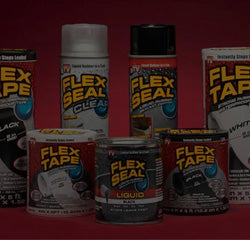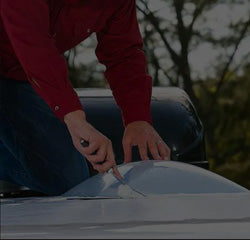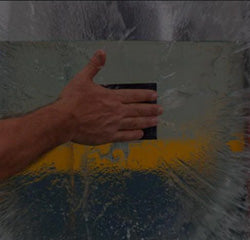How To Apply Flex Tape
Flex Tape has been shown to work effectively in a variety of situations. However, for best results, it should be applied the correct way.
How To Apply Flex Tape
1. Measure and cut, we recommend using a razor blade.
2. Clean surface of any dirt or oil.
3. Remove transparent backing.
4. Press firmly to apply, removing any air pockets.
How To Apply Flex Tape on Wet Surfaces or Underwater
For best results, when applying on wet surfaces or underwater, make sure the area being sealed is clean and free of any grease, oil, dirt, debris or algae. Only use on smooth, clean non-porous surfaces and applied at room temperature.
1. Keep the liner on and cut Flex tape to create a patch larger than the area being repaired. You can also round the corners of the patch to help prevent the corners from lifting.
2. Remove the liner and apply the Flex Tape firmly over the area being sealed. Once applied Flex Tape cannot be repositioned. For best results, apply Flex tape to both sides of the repair.
3. Press firmly using your fingers, squeegee, credit card, roller and continue pressing firmly starting at the center and working towards edges.
4. Make sure all water, air pockets, creases and folds have been completely removed. These are areas are where water could seep through and create a leak.
5. Continue pressing firmly for 1 minute or longer to allow Flex Tapes adhesive to completely bond to the surface being sealed.
May not adhere to certain surfaces such as siliconized or water-repellent materials. May cause damage to the surface if removed. Not intended for high pressure applications, such as garden hoses or engine repairs.
More Info and Tips
Use a razor blade instead of scissors when you can. After several cuts the super-thick adhesive in Flex Tape may affect the scissors ability to cut. To clean the Flex Tape adhesive off of scissors or other surfaces, we offer a Flex Tape remover that makes it easy to remove.
Make sure that you have removed the protective film, and press down firmly for best results. You can use a squeegee, roller or a flat item like a ruler to really press the tape onto the surface. Make sure to remove any air pockets.
Flex Tape will adhere right away, but it gets stronger over time, so let it sit for 24 hours if possible.Once fully bonded, Flex Tape cannot be re-positioned, so don’t try to move it and re-use it.
You can use a hair dryer on the back of Flex Tape to increase the bond to porous surfaces, such as concrete.
Flex Tape works on most surfaces, including: acyrlic, metal, steel, copper, aluminium, wood, ceramic, porcelain, tile, glass, rubber, fiberglass, stucco, plaster, stone, cement, concrete, drywall, EPDM roofs, some plastics, fabrics, vinyls and more.
Flex Tape may not work on some siliconized surfaces, greasy surfaces, water-repellent surfaces, or surfaces with harsh chemicals present (acids, mineral spirits, acetone, etc.)
Please note that Flex Tape is only recommended for normal hydrostatic pressure. It is not meant to withstand high pressure, such as a pressurized pipe or engine machinery.
Using Flex Tape on Above Ground Pools
It is also a good idea to apply Flex Tape to both the inside and outside of a container when possible. For example, with an above ground pool with a leak, apply a piece of Flex Tape to the inside first, then place another piece of Flex Tape to the exterior.
Using Flex Tape on a Hose
For best results, when using on a low pressure hose, apply a small piece of tape over the hole. Then wrap another larger piece over the first layer. Add another layer if needed. Flex Tape may not work with all hoses, and is not recommended for applications with high water pressure (such as garden hoses and hoses in a car engine.)
If you have any questions, feel free to reach out to our customer service team at (833) 411-3539.












































